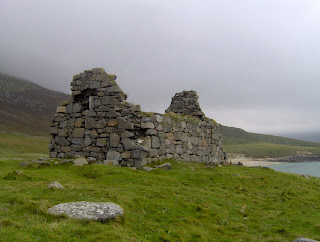Garth and Vicky met by chance on a train in Scotland when they were both widowed and in their 50s. They married, retired early and moved to the small island of Easdale off the island of Seil in Argyll. This book is an illustrated nature diary of their first year on Easdale - 1979. It is in the same format as Edith Holden's The Country Diary of an Edwardian Lady, which was published in 1977.
The diary includes details of what Garth and Vicky did and places they visited but it is mainly an illustrated account of the wildlife they observed - flowers, plants, mammals, birds, insects, marine creatures, reptiles and amphibians. There are no pages without at least one of Vicky's paintings. The diary entries, which are in Vicky's handwriting are interspersed with quotations and poems - some of them by famous poets and some written by Garth and Vicky themselves. It is a gentle book to dip into and savour. 7/10
Islands covered - Easdale, Seil, Luing, Mull, Iona
Former quarry workers' cottages
Ruined quarry building, Easdale
Harbour on Easdale
Village from the summit of Easdale

















































